
The creative testing blueprint: Strategies for high-impact ad campaigns
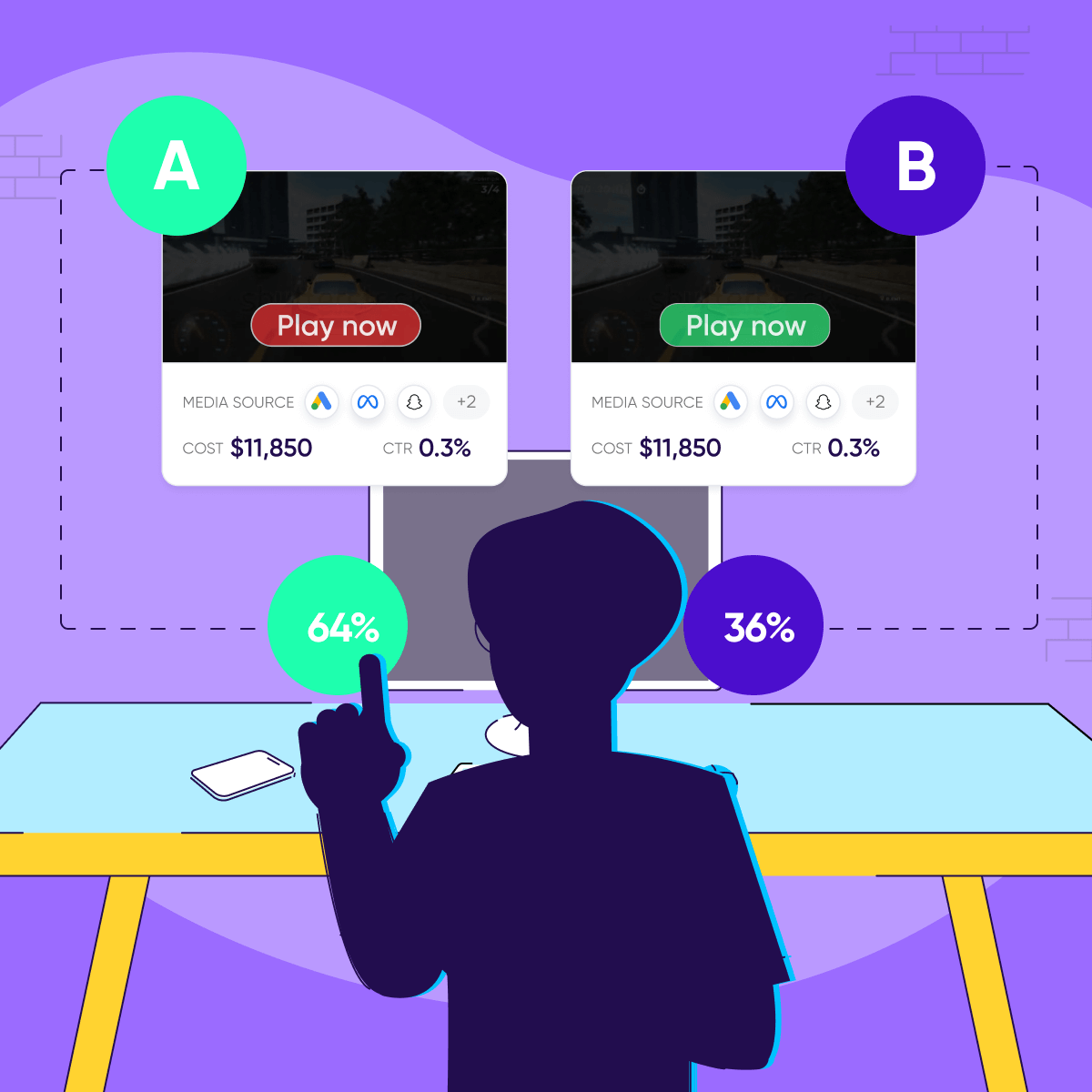
Have you ever wondered what makes a successful digital ad campaign, well, successful? In the current digital and app marketing landscape, where trends shift like the seasons, the answer is effective creative testing.
What is creative testing?
Creative testing, or advertising pre-testing, is a data-driven process that aims to predict how well an ad will perform in the market. It’s the weapon of choice for creative teams to make sure they’re spending their money on ideas that deliver tangible results.
Imagine you’re a maestro and your ad creatives are the notes in your symphony. This guide will teach you how to compose harmonious campaigns that resonate with your audience. From outlining the process to listing the key metrics, our aim is simple — to make creative testing accessible, enjoyable, and, most importantly, successful.
Let’s begin!
Why is creative testing important?
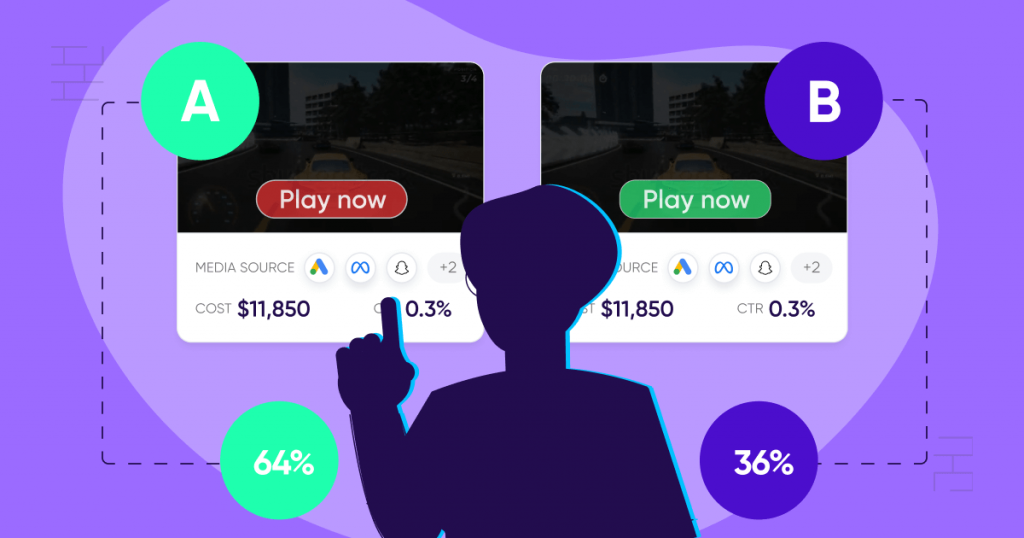
Creative testing serves a multifaceted role within digital and app marketing. It’s about more than simply creating new ads — the true purpose of testing is to craft ads that outperform previous marketing efforts. The goal is always to surpass the “control,” which represents the best-performing ad within a campaign that sets the performance benchmark.
As a business owner, you already have a lot to do, and trying out creative testing might seem like another big task. But in today’s competitive market, it’s a step you can’t afford to skip. To stay ahead, you need to consistently and constantly generate fresh creatives — otherwise, you risk creative fatigue and declining ad performance.
Creative testing makes sense for your bottom line, too. Without it, your creative process is less efficient and you could be wasting time and money on ineffective ads.
Here are some additional compelling reasons why testing your ad creatives is a must:
- Crafting compelling creatives: Creative testing helps you create engaging and impactful advertisements that resonate with your audience, improving the return on ad spend.
- Budget optimization: Creative testing helps you avoid wasting money on ads that don’t work. Instead, it helps you improve your ads by focusing on what makes successful campaigns, so you spend your budget wisely.
- Gaining valuable customer insights: Creative testing provides you with valuable insights into your customers’ thoughts about your campaign, aiding in better decision-making when designing creatives.
- Identifying interactive assets: Through creative testing, you can pinpoint which creative elements your audience interacts with most, including those that lead to conversions.
- Charting your next steps: Creative testing offers insights that validate concepts and guide you in selecting the right medium for your campaign, helping you scale your business.
In essence, creative testing is your compass in the advertising world, guiding you toward making ads that positively impact your audience, optimizing your budget, and, ultimately, ensuring better marketing results.
The process of creative testing
Let’s be honest: setting up and running a creative test is a learning curve. But don’t worry, once you get the hang of it, everything starts to fall into place. Here’s a step-by-step guide to get you started:
1 — Do a gap analysis to bridge the creative divide
Creative testing kicks off with a crucial step known as the gap analysis. Here, you evaluate what’s already happening with your ads, identifying gaps and opportunities in ad format, budget allocation, target audience demographics, messaging strategies, and more.
This sets the stage for refining your ad creatives to effectively bridge those gaps and align them with your overarching marketing objectives.
2 — Set goals/KPIs and hypotheses
Next, you need to define clear goals and key performance indicators (KPIs) for your creative testing endeavors. This step serves as your guiding star throughout the testing process, providing a clear direction for what you aim to achieve.

Setting hypotheses is also vital: these are the foundation for your testing methodologies, helping you make educated guesses about which creative elements will yield the best results. Think of it as placing bets on the most promising contenders in a race.
3 — Create multiple ad variations
With your objectives in place, it’s time to get creative — literally.
Develop multiple ad variations, each designed to test different elements of your creative strategy. These variations can include a wide range of factors, from headline text and visuals to call-to-action buttons and ad placements. By diversifying your creatives, you’ll gain a deeper understanding of your audience’s preferences.
4 — Choose a testing methodology
Selecting the right testing methodology is the cornerstone of creative testing success. You have several key approaches to consider, such as:
- A/B testing: Also known as split testing, A/B testing compares two versions of an ad (A and B), with one differing element to identify the better-performing version. You might reword the call to action, for instance, or put the button in a different place. This method helps isolate the impact of a single variable on ad performance. It lets you conduct a controlled experiment where you change one thing at a time to see what works best.
- Multivariate testing: If you’re ready to explore greater complexity, you can try multivariate testing. This methodology analyzes multiple variables within various ad elements simultaneously, allowing you to examine the collective influence of various elements to optimize ad performance.
- Lift testing: Lift testing measures the true impact of your advertising efforts by comparing the performance of your ads against a control group that hasn’t been exposed to the campaign. This approach provides invaluable insights into the incremental value your ads bring compared to the absence of advertising. Think of it as determining the actual influence of your marketing amid the noise of other factors.
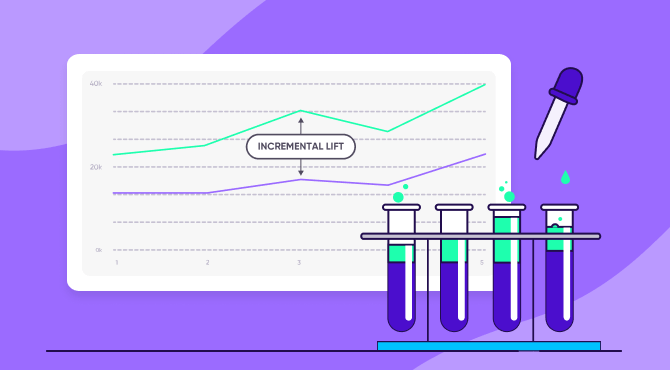
Each of these testing methodologies has its unique strengths and is appropriate in different situations. Your choice should align closely with your testing objectives and the insights you aim to extract.
5 — Set up and launch the test
Once your testing strategy is in place, it’s time to put it into action.
This phase involves setting up the test parameters, including ad distribution, audience targeting, and the duration of the testing period. Once everything is configured, launch your carefully crafted ad variations into the wild, ready to engage with your target audience.
6 — Analyze ad performance
With your ads running, it’s time to collect and analyze the data.
Build custom dashboards to visualize and interpret the performance metrics and KPIs you defined earlier. This will help you understand which creative elements are driving success and which need adjustments, guiding your optimization efforts.
7 — Continue to optimize
The creative testing process doesn’t end with the initial launch; continuous optimization is the key to sustained success.
Armed with insights from your analysis, you can refine and iterate on your ad creatives to keep improving performance. This ongoing process ensures your ad campaigns remain dynamic and responsive to your audience’s ever-changing needs and preferences.
Creative testing metrics
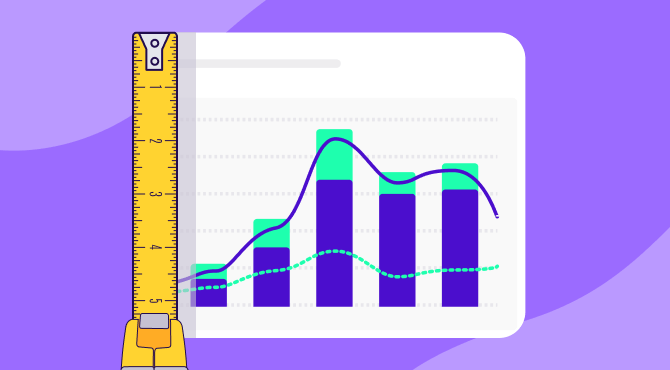
Nearly 90% of your core audience may not initially respond to a call to action in the way you intend. This doesn’t mean they aren’t paying attention — but it’s possible your ad creative isn’t resonating with them.
Measuring creative testing metrics allows you to overcome this problem, helping you identify the creatives that make maximum impact on your target demographic.
Here are some of the most important metrics to keep track of:
1 — Impressions
Impressions serve as the foundational metric of any ad campaign, representing the number of times your ads pop up on the user’s screen. Think of it as an initial reach and visibility check for your creative content.
2 — Three-second video viewers ratio
This metric goes beyond impressions, delving into engagement. It gauges the percentage of viewers who watch your video for at least three seconds, compared to total impressions. A higher ratio means your content is captivating enough to grab and hold the viewer’s attention.
3 — Average watch time
Average watch time offers insights into your ad’s effectiveness in attracting and holding the viewer’s attention by tracking the watch duration (how long viewers stay tuned to your content). If your average watch time is longer, it’s a sign your content is engaging and captivating.
4 — Link click-through rate (CTR)
CTR is your call-to-action’s report card, calculating the percentage of viewers who actually clicked on the provided link on your or completed your desired action after engaging with your ad. A high CTR means your ad is successfully inspiring action from viewers.
5 — Cost per acquisition (CPA)
Put simply, CPA is your budget watchdog, keeping an eye on the total money spent to acquire every new lead or customer. Tracking this metric helps you stay on top of the financial side of your acquisition efforts.
6 — Cost per conversion (CPC)
CPC tells you how much each successful conversion is costing you. By measuring this, you can better understand the effectiveness of your advertising efforts, enabling strategic budget optimization.
7 — Ad spend
Ad spend is the total amount invested in your advertising campaigns. Budget management is a linchpin of success, which is why you need to keep a watchful eye on this metric to ensure your spending stays on track.
8 — Return on ad spend (ROAS)
ROAS indicates the total revenue generated as a result of your ad spend. It shows you the real bottom line, giving you a clearer picture of the overall profitability of your ad campaigns. A ROAS above 100% means a positive return on investment.
Creative ad testing best practices
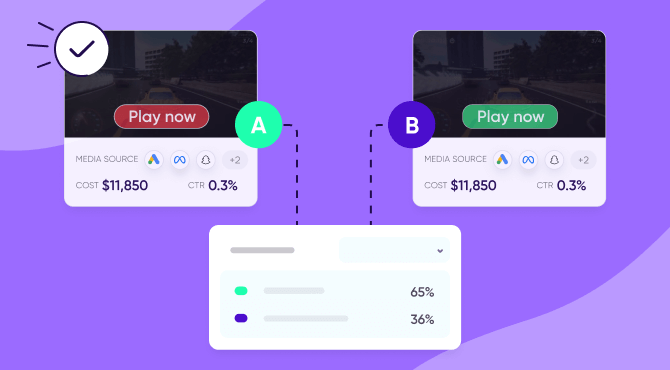
The point of creative testing is to find a winning ad creative combination. This means identifying the perfect blend of design and messaging, and scaling it to get your desired results according to a testing plan.
Below are some best practices to help you master the creative testing process:
1 — Have a solid hypothesis
By this, we mean figure out what you want to learn from the testing. This will guide you in deciding which variables to test, such as CTAs, images, headlines, and more. Be specific: for instance, you might want to find out if your audience prefers dark CTAs on a light background or light CTAs on a dark background.
Having a focused hypothesis gives you a rationale for your chosen assets. Without it, you can’t categorize your variables meaningfully, which may lead to an unfocused test and compromised data that isn’t as powerful or meaningful as it could be.
2 — Set your budget and allocate it evenly
To determine the ideal budget for your A/B testing, multiply the cost of each acquisition by the number of conversions. For instance, if you set a $10,000 conversion goal and your CPA is $2, your total testing budget should be $20,000.
Remember, each component of your test should have a similar budget. Otherwise, some versions might get more attention and exposure, which could affect the results.
3 — Develop a holistic creative testing roadmap
If you’re considering running several creative tests in a row, you need a clear testing plan that connects them. This helps highlight how they influence each other, ensuring your insights are continually useful and actionable.
Furthermore, be sure to prioritize mobile best practices. This means that every element of your ads should:
- Stay focused on expressing your creative ideas.
- Stand out from the other elements you’re testing.
- Maintain consistency without introducing extra variables that could affect your results.
4 — Don’t rush your tests
It’s important that your test runs for an adequate time to generate meaningful results.
Determine the optimal running duration for your tests based on your campaign objectives and audience size. If your test is too short, you may see fluctuations in performance. Similarly, running tests for too long may waste resources.
5 — Use automated testing tools
How does the thought of creating and adjusting every ad version by hand sound?
Creative testing at scale can be incredibly tough (and boring!) without some kind of automation in place. More importantly, it can lead to burnout, taking away time you could spend doing more valuable creative tasks.
Testing ad designs manually is no cakewalk either, as it’s hard to keep track of every aspect. Not to mention that paid social platforms don’t allocate ad spend evenly across all your versions, which can mess up the accuracy of manual tests.
That’s where automation comes in, allowing you to ditch the repetitive tasks associated with large-scale testing. Using automated testing tools, you can generate all possible ad variations and set up the testing campaign. This includes handling budgets, ad placements, and the audience, ensuring that every version gets a fair shot.
6 — Avoid exposing your test audience to other ads
Your test audience shouldn’t encounter ads unrelated to your creative testing campaign. If they do, it can lead to two outcomes:
- Users start to suffer from ad fatigue; or
- Users are motivated to take some type of action
In either scenario, exposure to unrelated ads changes your audience’s behavior, which can affect the accuracy of your test results. Your best bet is to set a fresh audience for every new round of creative tests. This will help maintain accuracy and ensure unbiased results.
7 — Don’t forget the IDFA/SKAN4 aspect
In the post-IDFA and SKAN 4.0 world, engaging your audience and staying relevant should be your number one priority. With less data and shifting KPIs, it’s all about crafting ads that truly connect.
Make sure your ads fit the context they’re in, so they feel right at home. You should also tap into insights across various platforms, integrate incremental testing to gauge the genuine influence of your ads, and leverage predictive modeling to make data-driven choices without compromising user privacy.
Key takeaways
- The goal of creative testing is to craft new ads that outperform previous campaigns. It also helps you fight off creative fatigue and optimize ad spend.
- The creative testing process is a comprehensive journey. It starts with a gap analysis, followed by defining goals and hypotheses. Then, it leads to creating multiple ad variations, selecting testing methodologies, launching tests, and finally, analyzing and fine-tuning performance.
- Measuring impressions, engagement, campaign costs, and ROAS is critical in setting your testing goals and optimizing ad performance.
- To excel in creative ad testing, begin with a well-defined hypothesis and ensure fair budget distribution. Plan the connection between your tests thoughtfully, avoiding rushed decisions to enhance result accuracy. Additionally, consider using automation to streamline the testing process.
- In a post-IDFA and SKAN 4.0 world, where data is scarce and user engagement is paramount, your ad creatives should seamlessly integrate with their context and establish a meaningful connection with users.
- Note that creative testing is an ongoing process that requires continuous learning and adaptation to achieve optimal results in digital advertising.




